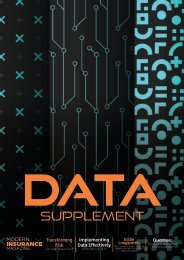Modern Insurance Magazine Issue 66
Insight: Unlocking Profitable Growth: Boosting Insurance Sales Efficiency by 18%, by Philipp Kaupke, Simon, Kucher & Partners Strategy & Marketing Consultants, Zürich Interview: Navigating a Complex Landscape by Richard Nash, Aon Interview: The True Meaning of Partnership with James Roberts, Europcar Editorial Board: Find out what our editorial board panel of experts have to say in this edition of Modern Insurance Magazine. Associations Assemble: Modern Insurance’s panel of resident associations outline the burning issues in insurance. The Fraud Board: Don’t miss our next instalment of The Fraud Board, where our growing collective of fraud experts convene to discuss the key factors affecting the fight against fraud in our industry today. FMG: Positive Cultures Attract Top Talent ParaCode: Do You Have A Healthy Relationship With Your Insurance Software Partner? Laird: Embracing Automation: Q&A with Nik Ellis Just a Thought with Eddie Longworth… ‘Groupthink’ Destroys Claims Integrity I Love Claims / ARC 360: Managing Expectations Amidst Cut-Back Cover Insurtech Insights: Interviews with Rob Newbold, Verisk; Franklin J. Manchester, SAS; Dr. Matthew Jones, Fathom; Charlie Sidoti, Innsure; Valkyrie Holmes, Faura; Dr. Maryam Golnaraghi, The Geneva Association. Insur.Tech.Talk Editorial Board: Experts from within the insurtech sector and beyond join us once more to share their unique insights
Insight: Unlocking Profitable Growth: Boosting Insurance Sales Efficiency by 18%, by Philipp Kaupke, Simon, Kucher & Partners Strategy & Marketing Consultants, Zürich
Interview: Navigating a Complex Landscape by Richard Nash, Aon
Interview: The True Meaning of Partnership with James Roberts, Europcar
Editorial Board: Find out what our editorial board panel of experts have to say in this edition of Modern Insurance Magazine.
Associations Assemble: Modern Insurance’s panel of resident associations outline the burning issues in insurance.
The Fraud Board: Don’t miss our next instalment of The Fraud Board, where our growing collective of fraud experts convene to discuss the key factors affecting the fight against fraud in our industry today.
FMG: Positive Cultures Attract Top Talent
ParaCode: Do You Have A Healthy Relationship With Your Insurance Software Partner?
Laird: Embracing Automation: Q&A with Nik Ellis
Just a Thought with Eddie Longworth… ‘Groupthink’ Destroys Claims Integrity
I Love Claims / ARC 360: Managing Expectations Amidst Cut-Back Cover
Insurtech Insights: Interviews with Rob Newbold, Verisk; Franklin J. Manchester, SAS; Dr. Matthew Jones, Fathom; Charlie Sidoti, Innsure; Valkyrie Holmes, Faura; Dr. Maryam Golnaraghi, The Geneva Association.
Insur.Tech.Talk Editorial Board: Experts from within the insurtech sector and beyond join us once more to share their unique insights
Create successful ePaper yourself
Turn your PDF publications into a flip-book with our unique Google optimized e-Paper software.
tech stakeholders about which risks be transferred to the<br />
insurance industry, and how that risk-sharing balance can<br />
evolve over time as the technology matures, or as more<br />
risks become known or measurable.<br />
Finally, this approach may very well accelerate the<br />
identification of unique, tech-specific insurance needs, all<br />
of which could require product innovation in commercial<br />
insurance markets and even other interventions, such as<br />
government backstops. Knowledge gained across projects<br />
could help expedite the development of risk management<br />
standards, guidelines and codes of practice.<br />
QGiven the complexities and large capital requirements<br />
of climate tech projects, the report highlights that<br />
traditional technology financing mechanisms (such as<br />
growth venture capital funding) are not sufficient at a project<br />
level. In light of this, we’re seeing an increased utilisation of<br />
project finance.<br />
That being said, re/insurers are traditionally contacted after<br />
the project has been designed for development at an approved<br />
site. What are the implications of this?<br />
A<br />
In this case, it often means that insurance-related<br />
considerations are not made during project design,<br />
potentially leading to risks being overlooked or<br />
underestimated. Such oversight could result in insurability<br />
challenges, delays or compromises in financing and<br />
execution.<br />
Engaging re/insurers’ risk engineering teams much earlier<br />
on would ensure that risks are considered, assessed and<br />
managed more holistically, enhancing the insurability of<br />
the project and potentially shortening the due diligence<br />
period for obtaining insurance. For example, extreme<br />
weather events can significantly damage or destroy<br />
industrial assets. Between 2019 and 2023, wildfires, floods<br />
and hailstorms all resulted in major losses for renewable<br />
energy facilities. Rising insurance costs and difficulty<br />
finding coverage are starting to limit where such projects<br />
can be built, particularly where the risk of weather-related<br />
events is above average. With trillions of public- and<br />
private-sector funding being mobilised to expedite the<br />
commercial deployment of new climate technologies<br />
over the coming decades, deciding where and how to<br />
build facilities will be critical to ensuring longevity and<br />
insurability over their life cycle.<br />
Involving re/insurers’ risk engineering teams earlier will<br />
help guide these decisions in those initial stages. Re/<br />
insurers can also work with project developers and their<br />
EPC partners to develop risk management strategies,<br />
such as contingency plans, advanced control systems, and<br />
sensors to anticipate system failures. All of these elements<br />
can be taken into consideration in the design phase,<br />
which enables proactive maintenance once the project is<br />
implemented. Re/insurers can also propose risk mitigation<br />
strategies through selection of equipment, such as the use<br />
of thicker glass or vertical solar panels for solar plants in<br />
zones with high hail risk, which may make a significant<br />
difference to the insurability of the project.<br />
QCan you expand upon the novel Insurability<br />
Readiness Framework (IRF) for advancing the<br />
commercialization of climate technology?<br />
A<br />
The Insurability Readiness Framework (IRF), which<br />
we developed through cross-sector collaboration,<br />
classifies climate tech risks into 7 categories;<br />
technology risk; project information and organisation risk;<br />
legal, finance and compliance risk; physical risk at project<br />
location; business interruption and supply chain risk; longterm<br />
risk; and environmental, social and governance risk.<br />
This framework allows climate tech stakeholders to<br />
consider risks through an insurance lens. The IRF provides<br />
a list of key issues under each category, enabling more<br />
informed conversations between climate tech stakeholders<br />
such as the developers, investors, engineering firms and<br />
re/insurers. In turn, this ensures that risks are considered<br />
and mitigation strategies are developed in line with<br />
insurance expectations.<br />
We also demonstrated how the IRF can be used to<br />
pinpoint areas within climate tech projects that pose<br />
the greatest challenges to insurability. We did this by<br />
using two technologies – carbon storage and green<br />
hydrogen. Finally, utilisation of the IRF during the project<br />
development and financing phases can also help to<br />
identify data requirements on a tech-by-tech basis.<br />
QWhat challenges lie ahead when it comes to<br />
implementing the recommendations in these reports?<br />
Speed and scale! Meeting global climate targets<br />
requires new climate technologies to be developed<br />
A rapidly, and deployed on a huge scale. The insurance<br />
industry has a crucial role to play here, but various<br />
challenges need to be overcome first in order to unlock<br />
full potential.<br />
Firstly, we are lacking practical mechanisms to engage<br />
re/insurers’ risk engineering teams directly with project<br />
developers and other stakeholders from the early pilot<br />
and demonstration stages. Re/insurers’ risk engineering<br />
capacities need to be expanded, and insurance markets<br />
also need to evolve in order to enable the scaled<br />
deployment of climate tech. There must be a greater<br />
understanding of insurance needs for funding climate<br />
tech projects through debt, and capital market financing<br />
needs to be improved. Finally, we must develop our<br />
understanding around how industrial sectors are adopting<br />
these emerging technologies, as well as the implications<br />
for their business models and related insurance needs.<br />
QWhat’s next for Dr. Maryam Golnaraghi?<br />
A<br />
Climate change is increasing the frequency and<br />
severity of extreme weather events. Our next<br />
project will assess the insurability of physical<br />
climate risks in light of this trend, and examine what’s<br />
needed to keep insurance affordable and available. This is<br />
a huge and rising concern in many countries with mature<br />
insurance markets, where in the absence of appropriate<br />
risk reduction and prevention measures such as land<br />
zoning, upgrading building codes and retrofitting existing<br />
buildings, insurance companies have been forced to limit<br />
or cease their offering of new policies. The project will<br />
bring focus to the need for a paradigm shift in the way<br />
society manages these risks.<br />
Dr. Maryam Golnaraghi<br />
Director - Climate Change and Environment,<br />
The Geneva Association<br />
MODERN INSURANCE | 65
















